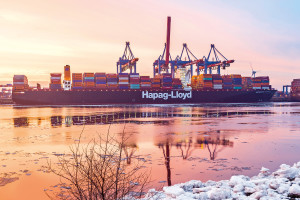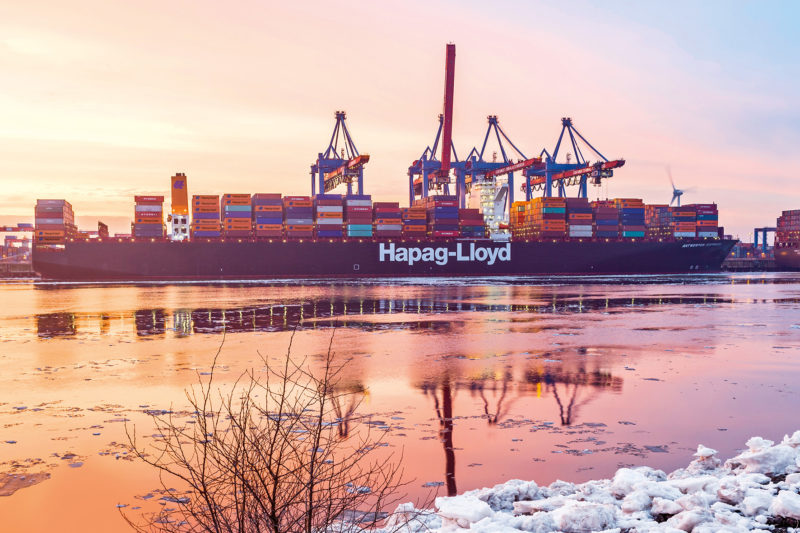 German box liner Hapag-Lloyd is reaping the benefits of the merger with Chilean shipping line Compania Sud Americana de Vapores (CSAV) as reflected in its strong earnings and volumes in the first half.
German box liner Hapag-Lloyd is reaping the benefits of the merger with Chilean shipping line Compania Sud Americana de Vapores (CSAV) as reflected in its strong earnings and volumes in the first half.
In the first six months of 2015, Hapag-Lloyd recorded a profit of EUR157.2 million (US$176.8 million) from a loss of EUR173.3 million for the same period in 2014.
EBITDA rose to EUR493.3 million compared to the prior-year period’s EUR67.2 million, while the operating result reached EUR267.7 million from a loss of EUR101.5 million year-over-year.
Hapag-Lloyd said it recorded strong operating results from January to June following the union with CSAV in December last year that made the company the fourth largest carrier globally by capacity.
Transport volume increased to around 3.7 million twenty foot-equivalent units (TEUs) in the first six months of 2015, up 29.4% compared to the same period in 2014. Average freight rate in the period went down, however, to US$1,296 per TEU, 9% below the same period last year.
“Besides the initial inclusion of CSAV’s container shipping activities, which have a lower freight rate level overall, the main reason for the decline was the ongoing difficult market environment with increased pressure on freight rates in the second quarter 2015,” according to an official statement.
Revenue in the first half also rose, going up by EUR1.5 billion to EUR4.7 billion. “Earnings increased as a result of initial synergies from the CSAV merger and additional cost savings from the Octave program,” said the carrier.
In the first six months of 2015, transport expenses went up a lot less than the transport volume as Hapag-Lloyd realized initial synergies from the merger and cost savings from the Octave program, the cost and efficiency initiative it rolled out in 2014.
The transfer of CSAV’s services and ship systems into the various trades of Hapag-Lloyd was completed in the second quarter of 2015, slightly ahead of the original plan.
“Now that the integration is almost completed, Hapag-Lloyd targets net annual synergies of around USD 400 million fully realised by 2017. This is USD 100 million higher than originally anticipated,” it said.
The Octave program, meantime, is expected to deliver annual improvements of about $200 million as of 2016. The program includes improvement initiatives in several areas such as procurement and further fleet modernization.
In its outlook for 2015 as a whole, Hapag-Lloyd plans to significantly improve its operating result (adjusted EBIT), taking into account “the persistently challenging industry environment.” This, it added, should be achieved by the synergy effects of the merger as well as additional cost savings under project Octave.
“Due to the comprehensive cost optimisation, it should be possible to achieve a clearly positive operating result (adjusted EBIT) in 2015. Earnings before interest, taxes, depreciation and amortization (EBITDA) are also expected to increase significantly.”
“After a solid start into 2015, we are satisfied with our results in the first half of 2015,” said Rolf Habben Jansen, CEO of Hapag-Lloyd. “Our results prove that the merger with CSAV was the right decision and an important milestone in the development of Hapag-Lloyd, as we already benefit from the integration—and also see the first results of the Octave program.”
He added that the company is on track to achieve positive full-year operating results in 2015. “The market environment remains very challenging, but we are well positioned in the market and remain highly resilient due to Hapag-Lloyd’s well-balanced portfolio of trades and services.”
Meanwhile, in a later statement, Germany’s biggest container-shipping line said it has decided to widen its cost-reduction target by $100 million and bring it forward by two years amid plans for an initial public offering in the coming months.
Annual spending cuts are now expected to reach $400 million as of 2017 and additional savings of $200 million will be generated starting next year, partly because of more efficient new vessels entering the fleet, said the Hamburg-based liner.





